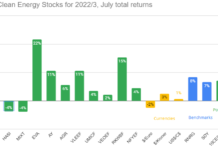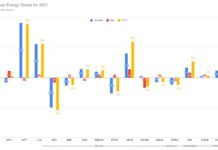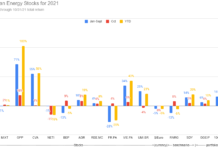Tom Konrad CFA
The History and Future of the “10 Clean Energy Stocks” Model Portfolios
2016 will be the eighth and possibly final year I publish a list of ten clean energy stocks I expect to do well in the coming year. This series has evolved from a simple, off-the-cuff list in 2008, to a full blown model portfolio, with predetermined benchmarks and monthly updates on performance and significant news for the 10 stocks.
While there is much overlap between the model portfolio and my own holdings (both personal and in managed accounts), the model portfolio is designed to be easily reproduced by a small investor who only spends a few hours a year on his or her investments. Trading is kept to a minimum by retaining many names from each annual list, and only trading in the middle of the year in extreme cases. There has been only one intra-year trade so far, in 2013 in the event of a bankruptcy.
Despite (or perhaps because of) the lack of trading, the model portfolios have performed well, at least relative to clean energy stocks in general. The model portfolio has outperformed its benchmark every year since 2008 except 2013. That year it returned 25% compared to the benchmark’s 60% return.
In the early years, the model portfolio mirrored the Clean Energy sector’s notorious volatility. More recently, I have attempted to focus the portfolio on less risky stocks, and this has allowed the portfolio to consistently outperform its benchmarks.
The move to less risky stocks has also been a function of my growing personal focus on high yield Clean Energy stocks. The only current Clean Energy mutual fund or ETF is the Global X YieldCo ETF (YLCO), which was launched in May. Its low liquidity and worse performance will probably prevent it from gathering enough assets for long term viability.
I’ve been talking to investment advisory groups and mutual fund companies about possibly launching a mutual fund or other pooled fund based on a Global Green Equity Income Portfolio (GGEIP) which I’ve been managing in a seed account since the end of 2013. The seed account has had excellent returns (up 6.6% in 2014 and 12.6% in 2015) while YLCO and fossil fuel based income alternatives have mostly fallen.
If I am successful in making GGEIP available to retail investors, SEC rules will likely prevent me from continuing to update the list regularly. That is why this may be the last such model portfolio. Or it may continue in a slightly different form: Aurelien Windenberger has offered to continue the updates if I am unable to.
The Making of 10 for 2016
Not only are income stocks my personal focus, but I believe that late 2015 will prove to be to be the best buying opportunity for clean energy Yieldcos. Yieldcos are public companies that own long term contracted clean energy assets such as solar and wind farms, and use the cash flows to pay a high dividend to shareholders. Many Yieldcos are listed subsidiaries of larger renewable energy developers. These stocks became market darlings in 2014 and early 2015, when investors flocked to them because they had seemingly created a magic formula to combine high current dividends with a high dividend growth rate. In fact, as I pointed out shortly before the bubble burst, the current dividends were unimpressive, and the cheap capital provided by seemingly endless investor enthusiasm was essential for the high dividend growth rates.
The Yieldco bubble popped over the summer, and I believe we have already seen the lowest point to which the sector as a whole will fall. That said, many Yieldcos remain amazingly cheap on an absolute basis, and so the best valued Yieldcos will form the core of this list. I recently wrote an article looking at Yieldco valuations using the dividend discount valuation model. An updated version of the most important graph from that article follows; the Yieldcos in this list will be selected because of their attractive valuations on this chart.

Read the article linked above for a full explanation of how to interpret the chart.
What Is A “Clean Energy” Stock?
Many followers of this series have noted that I tend to stay away from well-known green stocks, like Tesla (NASD:TSLA) and the solar manufacturers and installers most people think of first when they think of clean energy. This is not just because I prefer less volatile stocks. It’s also because I believe that avoiding well-followed stocks gives me a better chance of finding great values that other investors have overlooked. While some of these stocks may indeed be good values, they clearly have not been overlooked.
For any investor with limited time to do research (i.e. all investors), deciding where that limited time can (and can’t) be spent most productively may be the most important part of the research process. Investors who skip this step will inevitably squander valuable time researching stocks that are already well priced by the market. I try to avoid such stocks with some quick tools that help me quickly eliminate most stocks as potential candidates for further research, which I wrote about here. One of those tools is simply eliminating any company that might make good cocktail party conversation. Whenever I tell people I what I do, those who are interested in investing always bring up Tesla and/or solar stocks. Which is precisely why I seldom have much to say about such stocks, and you won’t see any of them in this list.
While I don’t try to be a boring conversation partner, I do try to keep my portfolio as boring as possible. Two other tools I use are looking for buying by company insiders, and low beta. Among less followed stocks with limited public information, I believe that the actions of insiders is a very important indicator of a company’s prospects. Low correlation with the overall market, or “Beta,” not only indicates less risky stocks, but much recent research has found that (contrary to traditional market theory) that low volatility and low Beta stocks tend to outperform the market as a whole over time.
For similar reasons, there are a couple stocks in this list that are not obviously “Clean Energy” stocks. For my purposes, if a company’s products or services reduce the use of dirty energy (i.e. fossil fuels), then it is a clean energy company. Renewable energy manufacturers, installers, and owners (such as Yieldcos) obviously qualify, but so do companies that sell insulation or help others manage vehicles more efficiently, even if those companies’ primary customers are fossil fuel companies themselves.
The following table shows this year’s list in rough order of riskiness (by my own subjective assessment) along with market Beta and a summary of recent insider trading activity.
| Ticker | Yield | Beta | Insider Buying? | |
| 1 | PEGI | 6.7% | 1.22 | More buying than selling |
| 2 | RNW.TO | 8.0% | 0.63 | Buying, no selling |
| 3 | EVA | 11.25% | N/A* | No trades since IPO |
| 4 | GPP | 10.51% | N/A* | No trades since IPO |
| 5 | NYLD/A | 5.8% | 1.02 | Buying, no selling |
| 6 | HASI | 6.3% | 1.22 | Buying, no selling |
| 7 | MIXT | 4.3% | -0.13 | More buying than selling |
| 8 | GLBL | 22.4% | 1.22 | No trades since IPO |
| 9 | REGI | – | 1.01 | More buying than selling |
| 10 | AMRC | – | 1.1 | Buying, no selling |
*EVA and GPP have not been public long enough to calculate Beta accurately.
Benchmarks
This year’s list consists of eight income stocks and two value/growth stocks. As in 2015, the benchmark for the income stocks will be YLCO, and the benchmark for the value/growth stocks will be the Powershares/Wilderhill Clean Energy ETF (PBW). I will benchmark the 10 stock model portfolio as a whole against an 80%/20% blend of the two, and also compare it to the Russell 2000 index ETF (IWM) to show how its performance compares to the broader universe of small cap stocks.
Income Stocks Added for 2016
Pattern Energy (NASD:PEGI)
12/31/15 Price: $20.91. Annual Dividend: $1.488 (7.1%). Beta: 1.22. Low Target: $18. High Target: $35.
Pattern is a Yieldco owning mostly wind projects in North America. While Pattern is smaller than most other Yieldcos, and has a more limited development pipeline from its sponsor, it has historically been able to acquire new projects at higher cash flow yields than its bigger rivals with higher profile sponsors.
The higher cash flow yields of Pattern’s projects are in part due to its emphasis on wind projects, and stronger independence at the Yieldco. Wind farms tend to have higher returns than solar because wind production varies more from year to year than solar, and the higher cash flow yields are compensation for higher risk. That said, the risk of variable production from wind farms is easily diversifiable. Since average wind speeds in one location have little correlation with wind speed in locations on other parts of the globe, let alone with solar production or the stock market in general, wind production risk production risk will have little effect on a highly diversified stock portfolio, and so the higher returns from owning wind farms come without significant added risk for the stock market investor.
The stronger independence of Pattern Energy from Pattern Development is by design. When Pattern Development offers Pattern Energy a wind farm for potential purchase, a committee of independent board members uses outside consultants to value that farm before price is ever discussed. The purchase only takes place if the eventual price falls within the range of that initial valuation.
Enviva Partners, LP (NYSE:EVA)
12/31/15 Price: $18.15. Annual Dividend: $1.76 (9.7%). Low Target: $13. High Target: $26.
Enviva Partners is a Master Limited Partnership (MLP) which owns wood pellet manufacturing and transportation infrastructure. Unlike wind and solar, the IRS considers wood products to be natural resources, allowing Enviva to use the tax advantaged MLP structure. The advantage of this structure is that returns to investors can be higher because MLPs avoid taxation at the corporate level. The disadvantage is that MLPs are partnerships, and limited partners (shareholders) receive K-1 tax forms which usually include Unrelated Business Taxable Income (UBTI) which, if the MLP is owned within an IRA or other taxable account, means that the account will have to file a separate tax return with the IRS. The added paperwork means that most investors will prefer to own MLPs in taxable brokerage accounts.
Most of Enviva’s customers are European power companies, which buy the partnership’s wood pellets under long term contracts. This market is expected to continue to grow quickly because converting coal plants to burn sustainably sourced wood pellets is easily one of the most cost effective ways for an electricity utility to reduce its carbon footprint. Enviva has most of its plants in the US Southeast, where the warm climate and plentiful rainfall results in fast growing forests which lend themselves to sustainable forestry.
Some newspaper articles have questioned Enviva’s sustainability practices with allegations of wood from clear-cutting old growth hardwood forests. While I believe it is possible that some wood from such clear cutting may have found its way into Enviva’s plants, I am confident that sale of wood to Enviva was not the motive for such clearcutting, and the company’s presence as a long term source of demand is more likely to encourage sustainable forestry than the opposite. First of all, Enviva’s plants cannot accommodate large logs, just the small trees and branches which might otherwise be burned in place or left to decay (and release its stored carbon) on the forest floor. Second, the vast majority of Enviva’s plants have FSC certification, which I consider to be the gold standard of sustainable certification for wood products. They would not be able to achieve this certification if they made a practice of accepting wood from unsustainable forestry operations.
Hence Enviva easily meets my green criterion that the company’s operations have the net effect of reducing greenhouse gas emissions.
Green Plains Partners, LP (NYSE:GPP)
12/31/15 Price: $16.25. Annual Dividend: $1.60 (9.8%). Low Target: $12. High Target: $22.
Like Enviva, Green Plains is a new MLP. The company owns ethanol production and transportation infrastructure. All of its facilities have long term contracts which protect the partnership from direct exposure to the commodity cycle.
Like wood pellets, corn ethanol has also been the subject of questions regarding its sustainability. Ethanol’s detractors often cite studies from the 1990s and early 2000s which showed that it required more energy inputs (in the form of fertilizer, fuel for harvest and transport, and heat for fermentation) than it produced when used to power vehicles. While there may have been truth to such arguments a decade ago, ethanol production has become much more efficient since then. Ethanol production is a commodity business, and as the industry has grown, ethanol and other biofuel producers have become the main source of marginal demand for commodity crops such as corn. With the price of ethanol effectively set by the price of oil, and the price of ethanol effectively setting the price of corn, only the most efficient ethanol producers can survive and make a profit. This market process has increased the industry’s overall efficiency, leading to n
et energy and greenhouse gas benefits from ethanol production.
I’m not going to argue that corn ethanol is as green as solar, wind, or even biodiesel. Nevertheless, it reduces greenhouse gas emissions and the use of oil in transportation in the existing vehicle fleet. Solar and wind cannot compare to ethanol in transportation until we have much higher penetration of electric vehicles, while biodiesel’s contribution is more constrained by the supply of suitable feedstock.
NRG Yield, A shares (NYSE:NYLD/A)
12/31/15 Price: $13.91. Annual Dividend: $0.86 (6.2%). Beta: 1.02. Low Target: $11. High Target: $25.
The term “Yieldco” was first applied to NRG Yield (NYLD and NYLD/A), and the company rode the Yieldco bubble in 2014 and early 2015. During this period, I was often short the stock, as a hedge against the other, significantly better valued, Yieldcos. Three of these (Hannon Armstrong, TransAlta Renewables, and Capstone Infrastructure (TSX:CSE, OTC:MCQPF) were in the 2015 list. While NYLD fell more than 50% in 2015, Hannon Armstrong, TransAlta Renewables, and Capstone produced total US dollar returns of 40.5%, -18.4%, and 2.9%, respectively. Now NRG Yield, and especially its A shares, have fallen so far that it has one of the best valuations in my DDM model.
Offsetting its very attractive valuation is the turmoil at its parent, NRG Energy (NRG), where the CEO recently stepped down because of investor skepticism about his aggressive green initiatives. NRG Yield’s low share price and likely lack of management support at NRG may reduce its future ability to grow, but not so much as to significantly undermine its valuation.
The reason I include the less liquid A shares rather than the more liquid and widely held C shares (NYSE:NYLD) is because this list is mostly targeted towards small investors for whom A shares should be sufficiently liquid for unconstrained trading. Other than liquidity, all the advantages lie with NYLD/A. Both classes of stock pay the same absolute dividend, but A shares are less expensive and produce a higher yield. A shares also have more votes, which will make them more valuable in any potential restructuring of the Yieldco.
Investors who do face liquidity constraints should consider splitting their purchase between the two share classes.
Terraform Global (NASD: GLBL)
12/31/15 Price: $5.59. Annual Dividend: $1.10. Beta: 1.22. Low Target: $4. High Target: $15.
Terraform Global had its IPO in late July, just as the Yieldco bubble was beginning to pop. It is easily the riskiest of all Yieldcos. It invests in relatively risky clean energy projects in developing markets like Brazil, China, India, and Brazil. Another significant contributor to its risk is its sponsor, SunEdison (SUNE). In order to avoid bankruptcy, SunEdison took complete control of both Terraform Global and its sister Yieldco, Terraform Power (TERP) in November. GLBL’s new management promptly announced that it would focus on acquisitions from SunEdison. The independent directors on the Terrafroms’ conflicts committees promptly resigned, stating that they could no longer ensure that all transactions between they Yieldcos and their parents would be to the advantage of the Yieldcos’ shareholders.
With the departure of the independent directors, TERP and GLBL shareholders must now rely on shareholder activism and class action lawsuits to make sure that SunEdison does not abuse its power at the Yieldcos. TERP’s shareholders found their champion in activist investor David Tepper, who seems to have been the impetus behind the renegotiation of SunEdison and TERP’s agreement to acquire Vivint (VSLR.) The revised agreement was to both SunEdison’s and Terraform Power’s advantage, but, in my opinion, the Yieldco got the best of the deal.
While Terraform Global is undoubtedly risky, it is also a great value. At the end of the third quarter, it held $9.50 in cash per share, well above the current share price of $5.59. The declared dividend is $1.10 annually, or 20%, so even though there is a risk that SunEdison will use GLBL’s cash to bail itself out of its financial difficulties, the threat of future lawsuits should ensure that that cash is exchanged for clean energy projects at something close to market prices. As long as those projects are sufficient to support the current $1.10 dividend, there should be significant upside for shareholders who buy at the current price.
Growth Stock Added for 2016
Renewable Energy Group (NASD:REGI)
12/31/15 Price: $9.29. Annual Dividend: $0. Beta: 1.01. Low Target: $7. High Target: $25.
Renewable Energy Group, or REG, is the leading producer of biobased diesel with a US listing. It replaces smaller biodiesel producer FutureFuel (FF) from the 2015 list. FutureFuel combined a biodiesel business with a large chemicals business which helped shield the company from the continued decline of the biodiesel industry and allowed it to produce a modest 5.5% total return while REG fell 4.5%. This year, all the factors are in place for a strong industry recovery, and so I’m switching my emphasis to the pure-play.
The factors driving the decline of the biodiesel industry were 1) regulatory uncertainty, 2) declining diesel (and hence biodiesel) prices, and 3) declines in the price of biodiesel feedstocks which lagged the declines in biodiesel. Regulatory uncertainty was greatly reduced when the EPA set target renewable fuel standard (RFS) volumes for 2014, 2015, and 2016 and reinstated the $1-per-gallon tax credit for biodiesel. While ethanol producers were generally unhappy with the new targets, biodiesel producers fared better.
Low crude oil prices are beginning to cut into production, especially shale oil production in the US, a trend which will mitigate future declines and set the stage for a potential rebound. Slower oil price declines will allow declines in the price of biodiesel feedstocks to “catch up,” which will improve biodiesel industry profitability. REG has used the industry downturn to consolidate its position as an industry leader, leaving it extremely well positioned to capitalize on any improvement in the market.
Returning Income Stocks
Hannon Armstrong Sustainable Infrastructure (NYSE:HASI).
12/31/15 Price: $18.92. Annual Dividend: $1.20 (6.3%). Beta: 1.22. Low Target: $17. High Target: $27.
Hannon Armstrong is a Real Estate Investment Trust and investment bank specializing in financing sustainable infrastructure.&
nbsp; It’s a leader in the disclosure of the net effect on greenhouse gas emissions caused by its activities. Hannon Armstrong was my top pick for 2015 as well as one of the three top performing stocks. I nearly dropped it from the list this year because so many other Yieldcos are more significantly undervalued, but in the end chose to keep it because of the company’s unique niche in financing clean energy which I believe gives it a significant competitive advantage over all other Yieldcos.
TransAlta Renewables Inc. (TSX:RNW, OTC:TRSWF)
12/31/15 Price: C$10.37. Annual Dividend: C$0.77 (6.7%). Low Target: C$10. High Target: C$15.
TransAlta Renewables produced disappointing returns in 2015, although its performance was much better than practically all other Yieldcos. It remains solidly in the list because it remains attractively valued. Its stock trades at an approximate 30% discount to my dividend discount valuation.
Returning Growth Stocks
MiX Telematics Limited (NASD:MIXT; JSE:MIX).
12/31/15 Price: $4.22 / R2.80. Annual Dividend: R0.08 (2.9%). Beta: -0.13. Low Target: $4. High Target: $15.
MiX provides vehicle and fleet management solutions customers in 112 countries. The company’s customers benefit from increased safety, efficiency and security. Like Ameresco, MIXT stock has fallen despite progress in the business, which has been regularly posting annual subscriber growth around 15%.
I attribute the stock decline to a combination of the oil price decline, the fall of the South African rand, and flat earnings caused by falling hardware sales as MiX shifts from a sales model to a bundled subscription model.
The oil price decline hurts MiX because a large proportion of its customers are in the Oil & Gas sector, and the falling rand hurts because South Africa is the company’s home market. Both oil and the rand could go up as easily as down in 2016, having a positive effect on the stock. Also, as more and more of MiX’s revenues come from subscriptions, earnings are becoming less sensitive to hardware sales.
MiX also reinstated its dividend in 2015, a move which did not seem to please the market, but makes it even more attractive to me.
Ameresco, Inc. (NASD:AMRC).
Current Price: $6.25. Annual Dividend: $0. Beta: 1.1. Low Target: $5. High Target: $15.
Energy service contractor Ameresco had been suffering for two years because its clients, mostly government entities, had been slow to finalize contracts. That has been turning around in 2015, and Obama’s recent initiatives to further improve energy efficiency in government buildings should help as well. Further, Ameresco has diversified its business into commercial solar installation, and that business will benefit over the next few years from the long term extension of the Solar Investment Tax Credit.
Despite all this, the stock fell again in 2015. Company insiders, especially CEO and controlling shareholder George Sakellaris, maintain their faith in the company by continuing to buy the stock in quantity. If other investors fail to recognize Ameresco’s potential in 2016, the stock has fallen low enough that he may decide to take it private.
Final Thoughts
Many income investors are particularly cautious now that the Federal Reserve has begun to slowly increase interest rates. But any interest rate rise promises to be very gradual, and the recent decline of Yieldco prices and the long term extensions of the Solar, Wind, and biodiesel tax credits should all help clean energy stocks in 2016. I expect this year to be a strong one for clean energy stocks in general, especially recovering Yieldcos.
Disclosure: Long HASI, CSE/MCQPF, AMRC, MIXT, FF, RNW/TRSWF, PEGI, EVA, GPP, NYLD/A, REGI, GLBL.
DISCLAIMER: Past performance is not a guarantee or a reliable indicator of future results. This article contains the current opinions of the author and such opinions are subject to change without notice. This article has been distributed for informational purposes only. Forecasts, estimates, and certain information contained herein should not be considered as investment advice or a recommendation of any particular security, strategy or investment product. Information contained herein has been obtained from sources believed to be reliable, but not guaranteed.







